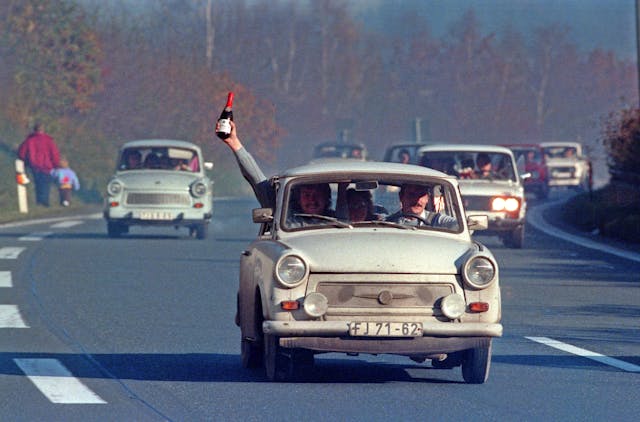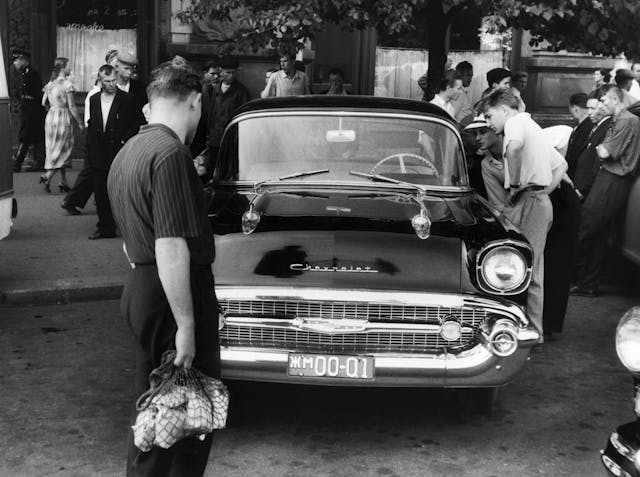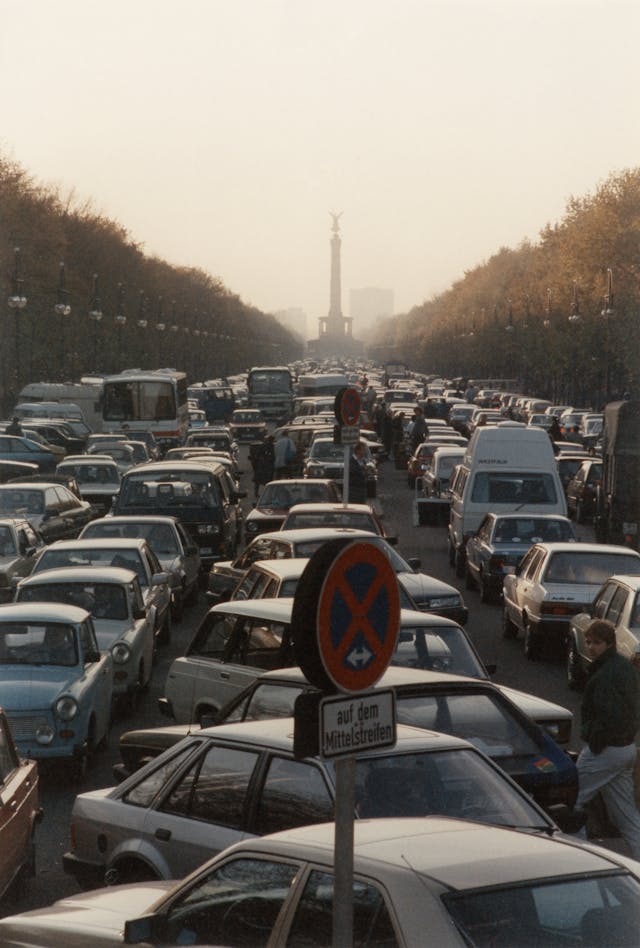Auto Anthro: A theory of Commie cars and communitas
Jack Swansey holds a degree in anthropology with a focus on car culture, and he is the world’s leading ethnographic authority (by default, if you must know) on NASCAR fandom. His love of the automobile fuels him to discover what cars mean to the people who own, drive, and love them. —EW
As a student of anthropology, I’ve read every ethnography of car culture I could get my hands on. Unfortunately, very few contained what I hoped to find: anthropological theories that discuss why people like me love cars. And why cars are more than ordinary appliances.
Automotive passion as a phenomenon, it seems, is not an area of academic interest. One anthropology book said something to the effect of, “You know, if all these otherwise-intelligent people stopped wasting their time on cars, they might actually achieve something with their lives.”
Those of us in the hobby know better. We understand that cars are intertwined with American culture, history, and daily life in fascinating ways. Anthropologists—who can write with beautiful nuance about the social lives of hurricanes, mushrooms, and even time itself—have a blind spot larger than a sixth-gen Camaro when it comes to cars.
I had a theory: To better understand the disconnect between the anthropology of cars and the experience of car lovers, I’d have to examine a culture divorced from 20th-century American cultural hegemony. That is, a society in which cars were treated as pure appliances for transportation, rather than personal expressions of taste, personality, and social status. Life behind the Iron Curtain seemed to fit the bill.

Turns out, things weren’t so black and white. “In the Eastern Bloc, perception of cars was more similar than you think,” says Dr. Pál Nyíri, professor of anthropology and global history at Vrije Universiteit in the Netherlands. Nyíri, who lived in Budapest and Moscow under Communist rule, explains that the automobile was treated as a special kind of commodity. “Cars were a symbol of modernity, masculinity, and power.”
Vladimir Lenin’s New Economic Policy allowed some commercial elements to permeate the economies of Soviet states. Imported cars in particular, many of them American, were only available to the powerful and well-connected. The classic satirical novel The 12 Chairs featured an ironic refrain, “The car is not a luxury item but a means of transportation,” that implied the exact opposite of what it said. Among ordinary Soviet citizens, Nyíri said, “[Communist] ideology was often used to mask hostility based on envy.” Automobiles—and especially the differences between them—were evidence an obvious social hierarchy, even in a supposedly classless society.

At the top of the ladder was GAZ, which produced limousines for exclusive use by high-ranking members of the Communist Party. The Ford-derived GAZ-A and GAZ-M1 were among the first Soviet-built passenger cars and became a menacing symbol of the secret police during Stalin’s Great Purge. The later ZiL and Chaika limousines represented similar status, with designated government lanes on Moscow highways known popularly as “ZiL lanes” or “Chaika lanes.” For most of the Soviet era, the GAZ Volga was the most prestigious car available, suggesting its owner was a well-placed official, successful plant manager, or big-shot actor.
One rung down was the Zhiguli/Lada, a Russified version of the Fiat 124 sedan produced under license. One of the few Soviet cars ever exported to the West, the Lada’s Italian bones made it a desirable choice for the Eastern Bloc motorist. Romania’s Dacia 1300 and 1100 were derived from the Renault 12 and 8, respectively, while the Polski Fiat brand the Fiat-derived Zastava (Yugo) were also revised for the Soviet market.

Least prestigious were the original Communist designs: the Russian Moskvich, Ukrainian Zaporozhets, and East German Wartburg, and Trabant. But even these were not affordable, as former Leningrad resident Meir Fradkin explained:
“The cheapest car was the Zaporozhets at 3000 rubles … at the time, an engineer’s salary was 150 rubles a month.” Fradkin’s father bought a Moskvich in the mid-1960s and drove the car until it was stolen in 1991, weeks before their family immigrated to Israel.
Visitors to Cuba have witnessed the extent to which keeping old cars on the road was vital, since purchasing a car was a multi-year affair. Without money or connections to speed the process along, wait times exceeded five years, and payment could only be made up front and with cash—often in the form of suitcases filled with rubles. Calling in favors to family and friends was essential for most people.
Dr. Oana Craciunescu, who emigrated from Romania in 1994, remembers how her father saved for his treasured Dacia 1100.

“In 1971, Dad left for Columbia [University] on a Fulbright scholarship. Communist Romania was a little more open, but you still had to be in good standing with the Party to leave … He stayed in the cheapest apartment and ate the cheapest food in the grocery store … only later he realized it was pet food.”
Even after a person got their hands on a car, the lack of mechanic shops and difficulty sourcing replacement parts made Eastern Bloc maintenance a fully hands-on experience.
“That Dacia never saw the inside of an auto shop,” Craciunescu says. “Dad knew how to do everything. That car was so precious to him that nobody could touch it.”
Fradkin agrees. “My father did it all by himself, from painting to engine rebuilds … [the] garage was his second home. Mom wasn’t too happy about that.”
For Fradkin’s father, parts shortages were of lesser concern. As an engineer working in a plant that built S-75 Dvina missiles, he had access to any equipment he needed to fabricate replacement parts for the Moskvich.
Gas shortages were common, filling stations scarce, and drivers limited to filling only one tank. Before a long trip, Craciunescu’s father always filled up the Dacia, siphoned the gas into jerry cans in the trunk, then drove to another gas station to fill up again. Fradkin recalls his father waiting at truck stops, hoping to sneak truckers a couple rubles for a few extra gallons.

Theft, to feed the ever-present black market, was also a concern. Fradkin’s father designed an alarm system for the Moskvich and brought the wiper blades home at night.
Despite the difficulty of ownership, both Fradkin and Craciunescu are certain their fathers loved their cars, even if they don’t fully understand why.
“[The Dacia] was like a member of the family,” Craciunescu says. “Everything to do with the car was allowed in the house … we had spark plugs on the kitchen table.”
Fradkin adds, “That [Moskvich] was his baby.”
***
My assumption that cars would have less social meaning in Communist societies was officially bunk. People loved their cars just the same. If anything, the social life of cars was more complex in the Eastern Bloc, even if as cars (officially) were symbols of distasteful Western consumerism while (in reality) representing what Nyíri described as the “Soviet craving for all that was foreign.”

The sweet taste of freedom and the open road seems universal. And if you’ve ever connected on car forums with enthusiasts around the world, the joy (and fury) of loving one’s car is apparent in a way that anthropologists do not grasp. For example: After one lengthy road trip through the Carpathian Mountains, Craciunescu’s family Dacia broke down just feet from their front door. Her father, joyous the car he’d named Paloma Blanca had waited two weeks for the perfect moment to expire, exclaimed, “What a wonderful car! What personality!”
Like gearheads everywhere, Eastern Bloc shade-tree (or in this case, missile-factory) mechanics understood their cars as holistic systems composed of parts whose functions relate to one another (valves, pistons, crankshafts, and so on). Engaging with those systems engendered what Hagerty’s own Kyle Smith would call “mechanical sympathy“—knowing enough about how a car works to become one with the machine.

In anthropology, an “assemblage” is a web of relationships among human and non-human elements that is culturally perceived as an entity with its own inherent attributes. Brands are a great example of assemblage in action: the Golden Arches brings to mind the taste of a Big Mac, along with the image of the uniformed cashiers, the smell of the fry oil casting a 100-foot radius around the restaurant, and so on. All exemplify parts of what we know as McDonald’s, but without the context of the others, none of these individual elements capture the full experience of “McDonald’s.”
A car is an assemblage in a more literal sense, composed of the tens of thousands of mechanical pieces that add up to a whole. But what has enmeshed the automobile in culture is the intangible, symbolic components that shape life on four wheels. By wrenching, driving, building models, or taping a car poster to our wall, we make ourselves part of an assemblage—a piece of the machine as crucial as a spark plug.
Maybe that’s the anthropological theory of enthusiast culture I’ve been seeking. One that explains how and why cars function as far more than consumer goods. The common denominator is that our relationship to cars is itself social. Cars connect us.
Humans are, after all, social animals. We are drawn to the feeling of being part of something larger than ourselves (communitas, in anth-speak). Being at one with the machine, and thus sharing a deep experience with other car enthusiasts, strikes that chord. The cars themselves don’t love us back, that much is clear. But when Paloma Blanca waits to break down until we reach our front door, it sure feels like they do.

***
Check out the Hagerty Media homepage so you don’t miss a single story, or better yet, bookmark it. To get our best stories delivered right to your inbox, subscribe to our newsletters.



Great story! Very interesting…thanks for sharing with us.
The automobile represents freedom. Everyone yearns to be free.
That freedom is under siege in so many ways here in the US and the western world.
Great article! I was in Dresden regularly in the mid 2000s as we had a contract with Airbus Deutschland to modify some of our aircraft at a local plant and I remember one of the engineers recounted his time prior to reunification. He mentioned that he was told in his early 20s that if he ever wanted a car, he needed to get his name on the waiting list as availability due to inefficiency of the factories was one of the biggest problems. This was to get a Trabant, not an “upscale” Lada.
We got the Lada up here in Canada back in the early ’80s. People went nuts over them because they were so cheap.
They soon found out what a POS the car was, and after a short time, most went to the scrapyard.
When the Russians shot down that Korean airliner in ’83, that sealed the brand’s fate.
This piece brings to mind a Car and Driver story written by P.J. O’Rourke. He was in Russia doing a sports article and some execs from a car company got wind of it so they thought they could capitalize (?) on his visit by giving him a tour of their facility and hopefully getting a positive report. During the tour he pretended to listen intently to the translated dialogue but he was also keeping track of the goings on of the workers. He noticed a crew that was moving boxes from one end of the factory to the other. A short while later this same crew was moving boxes in the opposite direction. P.J. kept an eye on this activity and was convinced that this was a “make work”situation and was pleased to report this in a C&D column when he got back. By the way there is a Lada Niva rotting away in a back yard here in Port Alberni (BC Canada) if anyone wants a restoration challenge.
I have owned two “Commie cars,” admittedly not what the common person could ever aspire to. The first was a GAZ 13 Chaika, an ugly Packard inspired car that made up in sheer quality of construction and surprising performance what it lacked in aesthetics. The second was a Tatra 603 – the most technically amazing car I’ve ever seen – rear engine air cooled HEMI V8! And built by Communists!